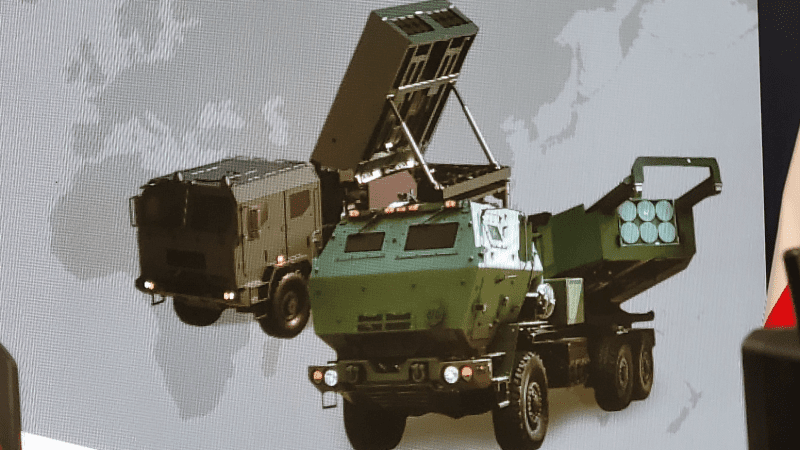Industry
Polish "Wheels" and "Ears" for Chunmoo and HIMARS. Polish Industrial Share Unveiled [REPORT]

The PGZ-WWR consortium, responsible for the rocket artillery procurement, has concluded an agreement with the Armament Agency that’s representing the Treasury, defining the principles and conditions for concluding the individual performance contracts on commissioning of the domestically-manufactured elements of long-range artillery fire modules. The above refers both to the HIMARS systems and the Korean K239 Chunmoo as well.
The agreement was approved by the Deputy PM, Polish Minister of Defence Mariusz Błaszczak, at the Polish Ministry of Defence. "We are going to great lengths to maximally utilize the potential that the Polish defence industry offers, by boosting its development via actions such as the ones undertaken today. Within the framework of the agreement, PGZ would manufacture Jelcz base platforms for the launchers imported from the US, and Korea, along with reconnaissance vehicles, munitions transporters, recovery7 vehicles, command vehicles, communications assets, and unmanned systems", Błaszczak listed. He added that Poland would receive the first Jelcz-based Chunmoo launchers next year.
Sebastian Chwałek, President at PGZ suggested that the contract would allow the PGZ to obtain new know-how. During the first phase of the contract, we'd be delivering components when it comes to Jelcz trucks and the whole WWR system modules. Ultimately, the PGZ Group would be handling the maintenance and servicing of those systems, as they are to be used for several years, as has been assumed. We would create a support and overhaul system. At the next stage we intend to take over the manufacturing of the primary elements of this system, launchers and the effector included, and perform it domestically, Chwałek said.

The PGZ-WWW consortium led by the Polish Armaments Group also includes the following entities: Huta Stalowa Wola S.A., Jelcz sp. z o.o., Rosomak S.A., Wojskowe Zakłady Łączności nr 1 S.A., and PIT-Radwar S.A. Other PGZ Group companies would be acting as subcontractors, along with other Polish defence industry entities.
The programme is aimed at commissioning national long-range rocket artillery modules, and it is the second most valuable undertaking involving the Polish defence industry, alongside the Narew system. The estimated cost is to exceed PLN 20 billion, with the expected volume of orders (mainly concerning vehicles, ranging from 4x4 to 8x8 platforms) would come in a number expressed in several thousand examples.
The elements that would be delivered by the PGZ-WWR consortium include Jelcz special trucks, that would accommodate the US- and Korean-made launcher systems, artillery reconnaissance vehicles, command vehicles, munitions transporters, ARVs, UAVs, C2 network, radars, and a comprehensive logistics package. The contracting process regarding individual performance contracts is planned to happen early next year. This would make it possible to begin deliveries in 2023 as well.
The spokesperson for the Armament Agency, Lt. Col. Krzysztof Płatek said that We are dealing with three key ingredients of the project aimed at building the long-range rocket artillery systems, namely the HIMARS pillar, the Chunmoo pillar, and the pillar revolving around all elements securing those systems. Summing it up, including the integration of Korean and US-made elements on the Jelcz trucks, the Topaz system, and delivery of the environment for this system, support and logistical vehicles, we are dealing with more than 40% of the value of this programme that would be placed in the hands of the Polish industry.
Lt. Col. Płatek emphasized the fact that those assets are just a fraction of the benefits the Polish industry would gain, as transfers of technologies are also expected, and included in the agreement signed with the Koreans. Here we are speaking of maintaining, servicing, and ultimately manufacturing the launcher. We also plan in the second phase of the Homar programme, the HIMARS acquisition, for everything to be Polonized. We also want to acquire relevant technologies, but this would become clear during the talks tied to the second phase of this programme.
As Col. Michał Marciniak suggests, the WWR (MLRS) base combat element would come in a form of a squadron fire module (DMO). Each of the DMO elements would consist of 18 launchers, a munitions stockpile with varying ranges, and several support vehicles (munition carriers, command vehicles, reconnaissance platforms) and support assets (logistics). It is assumed that more than 150 equipment units would be assigned to a single module as such.
The WWR system has been based on the idea of the maximum plausible unification of components, based on the domestic defence industry's capacity, and with the use of the effector subsystem (launcher and rockets), supplied by a foreign manufacturer.
The WWR system has been based on three primary pillars:
- The acquisition of the HIMARS launcher modules and munitions, and subsequent integration of those with the Polish TOPAZ suite, and Jelcz vehicles.
- The K239 acquisition (munitions included), and subsequent integration of those launchers with the Polish TOPAZ suite, and Jelcz vehicles.
- The acquisition of the remainder of the system, based on the domestic industrial potential.
The first task would be handled with the use of a staged approach. First, in 2023, Poland would receive a complete HIMARS squadron matching the US Army base configuration - 20 launchers, two for training, and munitions. Then, only certain components of the US-made system would be ordered (such as the launcher modules). They would subsequently be integrated and complemented with the Polish components of the system, such as the command vehicles, or munition carriers. The talks that are going on now pertain to the possible manufacturing of some launcher and rocket components at some of the Polish defence industry facilities. A possible establishment of a HIMARS maintenance centre in Poland is also on the table. A facility as such would render services both for the Polish Armed Forces, and foreign users as well. The relevant contracts between Poland and the US are expected to be concluded in mid-2023.
When it comes to the cooperation with the Korean partner, the first executory agreement on the procurement of 218 launchers has already been signed (this includes two for training purposes). A proper munitions stockpile is also covered by the aforesaid contract. The agreement in question additionally envisages the integration of the Korean system with the Jelcz trucks, and the TOPAZ system, whereas the manufacturer of the latter would be acting in a capacity of a subcontractor for the Korean entity. The delivery schedule in the agreement assumes that the first 18 launchers based on the Polish Jelcz trucks would be delivered in 2023, with the tempo of deliveries being accelerated throughout the subsequent years. The second performance contract assumes that 70 launchers and a major quantity of munitions are acquired - these assets however would be manufactured at the Polish manufacturing plants.
The order pertaining to procurement of the launches planned to be manufactured in Poland is aimed at scaling up the investment, to the level required to establish future maintenance and upgrade potential. That means that the investment tied to the delivery of large quantities of equipment in a short period would not be scaled excessively. When it comes to munitions, Poland expects a complete transfer of the manufacturing capacity (technologies and know-how included) to Poland. Business solutions pertaining to the formula of collaboration between the Polish and Koran industry, as well as the scope of the technology transfer, and investment cost would be described within an Industrial Feasibility Study. Approval of that Study issued by the Polish Ministry of Defence would be a condition required to be met before the second executory agreement is negotiated. More importantly, the talks on that matter, between PGZ and Hanwha, are scheduled to begin on 22nd November this year.
Last, but not least, Polish components of the WWR system would be acquired, both from the PGZ Group companies, as well as other domestic manufacturers. As mentioned above, maximum equipment commonality between the DMO elements is a must. The above means that the individual modules would only differ when it comes to the munitions they would be using, and the launcher configuration. The primary elements of the Squadron Fire Modules should include the following:
- Launcher base platform, 6x6 or 8x8 Jelcz trucks depending on configuration, respectively for the M142 HIMARS, and K239 Chunmoo launchers.
- Artillery ammunition carrier vehicles - based on 8x8 Jelcz LRPT (Large Repair Parts Transporter, developed for the Wisła programme) trucks,
- Battery- and squadron-level artillery command vehicles, based on the Polish 4x4 and 6x6 Tatra vehicles,
- Artillery reconnaissance vehicles, based on the Polish 4x4 Tatra vehicle,
- C2 vehicles, ICT nodes, cable vehicles, mobile command station modules, all based on Jelcz platforms of varying configurations,
- Logistics support vehicles, including 4x4 Jelcz medium capacity/high mobility trucks, 6x6 Jelcz high capacity/enhanced mobility trucks, electronics/armament repair vehicles, universal containerized repair stations, tank trucks, electrical power plants, and so on.
The equipment listed above would be procured within the framework of the subsequently concluded performance agreements. All of those agreements would either pertain to a specific area (logistics), or the specific nature of the relevant product (artillery command vehicles for instance). The agreement conclusion schedule is tied to the effector component delivery deadlines and the resulting boost in the rocket artillery capabilities. The adopted method for implementation of this project, based on performance contracts, makes project management easier, also diminishing the risk of failure.
Looking at that matter through the lens of the developing structure of the Polish Armed Forces, the project, as a whole, covers a prospect in which 28 DMO elements would receive domestically-manufactured equipment. Hence, the implementation could be seen as the second most significant procurement assigned to the Polish defence industry (during the post-1989 period), right after the Narew system. As a result, the Polish industrial share would constitute more than 40% of the total project value. Transfer of technologies would be a very important element of this undertaking, making it possible to manufacture the launchers and the munitions domestically. This is a major added value when it comes to the establishment of brand-new fields of expertise among the Polish defence industry players. One should also remember that absorbing all of those technologies would also require infrastructure investments, the establishment of production lines, and the training of designers and manufacturing staff. This may take up to 4-5 years. The above means that procurement of foreign systems manufactured domestically may become available as of 2026-2027.
The implementation of the whole programme based on performance contracts, with different contractors, and deadlines, and the subsequent coordination, fits well with the global project management standards and approved methodologies. Approach as such is by no means weakening the negotiating strength of the Ordering Party, or the Polish industry. The project's goal is to deliver a comprehensive set of combat capabilities to the Polish Armed Forces, and a manufacturing, maintenance, and servicing capacity to the Polish industry, throughout the whole lifecycle. Furthermore, when it comes to the performance agreements signed with the foreign partners, the dates of conclusion do constitute a compromise between rapid delivery of the equipment, translating into a relevant boost of the Polish Armed Forces' operational capabilities, and preparation of the Polish industry for the launch of manufacturing of the WWR system components.
